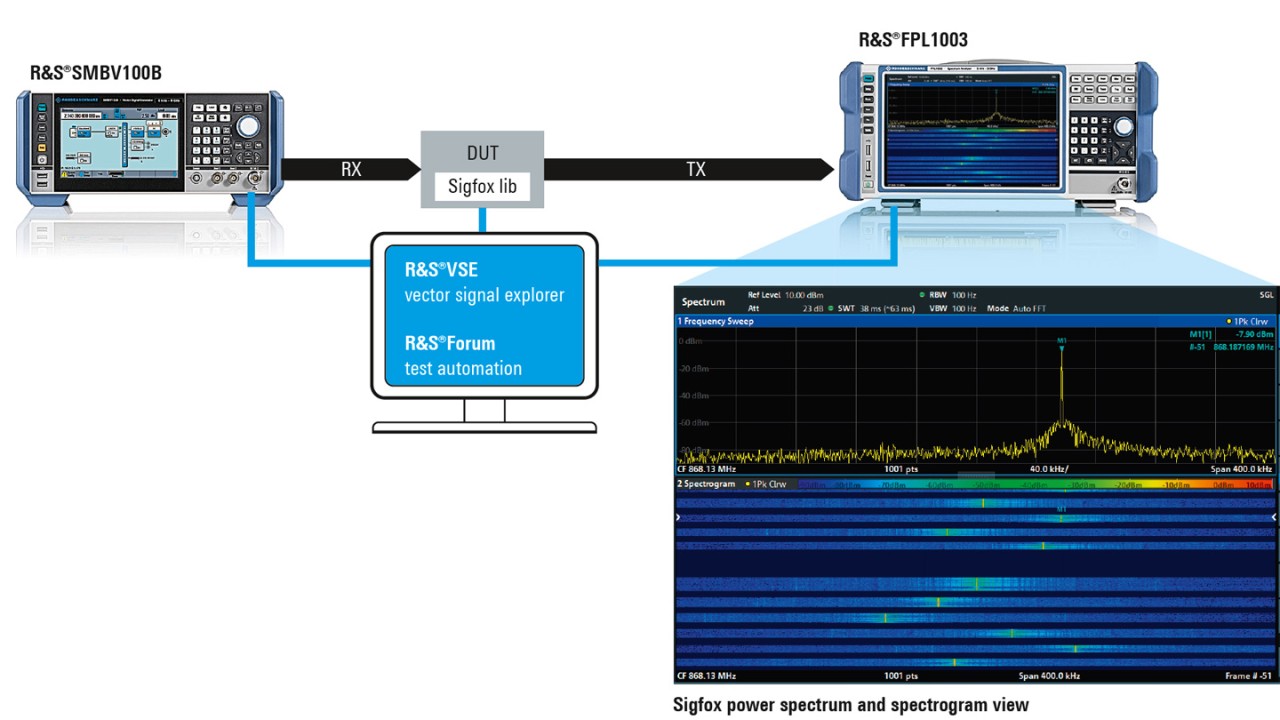Are you ready to connect to Sigfox?
Performing essential RF tests gets your Sigfox device ready for certification and deployment

Performing essential RF tests gets your Sigfox device ready for certification and deployment
Sigfox wireless technology is one of the most prominent low-power wide area network (LPWAN) technologies designed for sensor networks. It requires only a tiny amount of uplink data capacity. Sigfox is an ultra narrowband (UNB) technology that, together with frequency hopping and frame repetition, makes it resilient to interference.
For best performance and interoperability, it is recommended to test some of the essential RF parameters in the lab before applying for the required Sigfox certification and regulatory compliance certification. This saves time and money and helps achieve the best customer experience. Typical measurements include the transmit power, spectrum and frequency drift and receiver sensitivity.
The compact Rohde & Schwarz test solutions support all main wireless communications standards. The test setup for efficiently performing the required RF tests on Sigfox devices typically consists of the R&S®FPL1003 spectrum analyzer, the R&S®SMBV100B vector signal generator and a software tool that is able to control the device under test (DUT) using the Sigfox test library on the DUT. Additional sequencer software allows automatic execution of all test sequences.
Transmitter measurements
To perform spectrum measurements, the Sigfox DUT needs to be triggered periodically by the software tool. The DUT responds to each transmitted trigger with three sequential frames at three different frequencies. It is more convenient to use the test mode of the DUT supported by the Sigfox library. This allows, for example, periodic sending of test frames on a dedicated channel.
A spectrogram (as shown in the test setup diagram on the next page) visualizes the test results, providing information in frequency, time and power domains. Use the horizontal position and the marker reading to determine the transmit frequency and power for each frame. The vertical position of each block shows the time relationships of transmitted Sigfox frames. The color variations on the spectrogram identify the hopping frames and the radiated power of each transmitted frame.
Depending on regional regulatory requirements, a Sigfox device has to transmit within a predefined spectrum mask. Easily perform such tests by setting user-defined limit lines on the R&S®FPL1003 spectrum analyzer.
Phase and frequency errors are other key parameters for a Sigfox transmitter. The R&S®VSE vector signal explorer software demodulates the Sigfox signal and analyzes the relevant parameters such as phase error and carrier frequency error. For this purpose, the R&S®VSE software running on a standard PC captures the I/Q data from the connected R&S®FPL1003 for demodulation.
Receiver measurements
For downlink communications with the device, Sigfox uses 2GFSK modulation. In general, it is only possible to communicate with the device during the short periods of time when the device switches on the receiver, for example after sending a message to the network.
To meet the extreme coverage requirements, Sigfox specifies a receiver sensitivity of less than –126 dBm for the device. To measure the receiver sensitivity, the R&S®SMBV100B generates a certain number of Sigfox test messages at a defined output power of e.g. –125 dBm with its internal realtime baseband generation capabilities. The test program running on the device supports the determination of the packet error rate. To meet the Sigfox requirements, the device needs to successfully receive at least 900 out of 1000 frames (PER ≤ 10 %) at a power level of –126 dBm.
The RF performance of an IoT device that uses LPWAN technology such as Sigfox is critical to passing the required certification. It also has a serious impact on the reliability of the IoT solutions. It is highly recommended to verify and optimize the RF performance of a Sigfox device during the design phase. The measurements are straightforward and easily accomplished with off-the-shelf Rohde & Schwarz signal generators and signal and spectrum analyzers. Support of all main wireless communications standards and upgradeability make such test instruments a future-ready investment.

